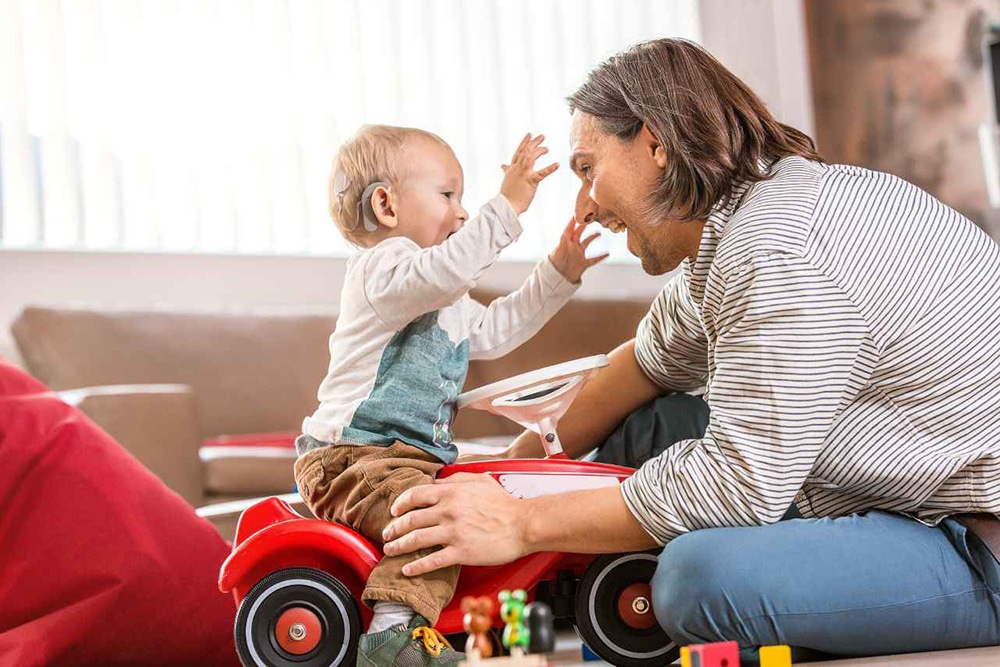MED-EL
Published Jun 24, 2016
The Four Stages of Building Your Child’s Auditory Skills
As soon as your child has had their cochlear implant activation, they’ll start being able to hear sounds. By giving your child lots of access to meaningful sounds, from the very first days, you can help them to connect these sounds with their meaning.

Developing auditory skills lays the crucial foundation on which your child will build many of their listening and communication skills. Although every child develops at a different pace, this development typically happens in four stages:
Step 1: Awareness of Sounds
When a child has just had their audio processor turned on, they probably won’t know what a specific sound means. That’s okay—this is a skill that will come later. Right now, what’s important to focus on is making sure that your child can recognize that a sound exists.
For the youngest children, this might be a reflex like widening their eyes, lifting their eyebrows, or smiling. For a slightly older child, this might be making a gesture or sound or searching for whatever they heard.
Here’s a game you can play to help build your child’s sound awareness: the “keys” game:
- Get some keys and two similar, opaque, boxes.
- Show your child that the two boxes are empty.
- Then, out of your child’s sight, put the keys into one of the boxes.
- Turn back to your child and shake one of the boxes.
- If it contains the keys, your child should hear them ringing around.
- Nod, smile, and say “yes, I can hear the keys!”
- Then open the box to show your child the keys.
- Again, say to your child “there are the keys! We heard them jingling in that box! That sound was from the keys.”
- Then, shake the other box.
- It won’t make any noise, so don’t respond with any gestures.
- Open it to show your child that it is empty.
- Say to your child “I can’t hear anything. And there’s nothing in this box making sound. There’s no sound.”
- After some time, when you shake the box with the keys your child will begin to indicate that they have detected the sound. They might do this by nodding, pointing, or babbling. This means that they’re starting to tell if a sound does or doesn’t exist.
Step 2: Paying Attention to a Sound
Therapists call this “attending” to sound, which basically means they’ll actively focus on a sound that they hear, or listen to. You might notice this happening when your child stops talking or babbling when they hear a sound; or conversely starts talking, blinking, or looking around when they hear a longer sound, such as a song finish.
All of this indicates that not only can they recognize that a sound does or doesn’t exist, but they also begin to understand that some of these sounds can be useful to listen and attend to.
Step 3: Conditioned Responses to Sound
Once your child is able to recognize sounds and pay attention to them, the next step is responding to sounds in a certain way.
For example, you could play with some stacking blocks and a short song:
- Give your child some stacking blocks; at the same time, you should be holding a similar block.
- Hold the ring or block.
- Then play a short song, and point to your ear to show that you’re listening.
- As soon as it has ended, open your eyes wide or frown a little to indicate to your child that the song has stopped.
- Then, drop what it is that you’re holding into a container or bucket.
- By doing this over and over, you can help your child associate the stopping of the song with the dropping of the block.
There are many other childhood games that can help your child learn to respond to sound. One is singing “Ring around the Rosie,” which will help your child learn to fall down when they hear the lyrics “…and we all fall down!”
Step 4: Associating Sounds with Meaning
When your child has begun to master these first three steps, then they’ll start understanding that certain sounds have certain meanings. And, they’ll be able to differentiate between different sounds: the high and low sounds, long and short sounds, loud and soft sounds.
For example, if they hear the microwave beep they’ll look directly at the microwave. You might notice that they no longer search around to find what is making the noise, because they know that this sound is associated with the microwave.
Then, as your child’s listening and language skills continue to develop, they’ll be able to start following simple sound-based directions spoken to them like “sit down,” or “come here.”
And once they’ve mastered all four of these steps, they’re well on their way to developing their listening and language skills!
References
MED-EL
Was this article helpful?
Thanks for your feedback.
Sign up for newsletter below for more.
Thanks for your feedback.
Please leave your message below.
Thanks for your message. We will reply as soon as possible.
Send us a message
Field is required
John Doe
Field is required
name@mail.com
Field is required
What do you think?
© MED-EL Medical Electronics. All rights reserved. The content on this website is for general informational purposes only and should not be taken as medical advice. Contact your doctor or hearing specialist to learn what type of hearing solution suits your specific needs. Not all products, features, or indications are approved in all countries.
MED-EL



Conversation
3 Comments